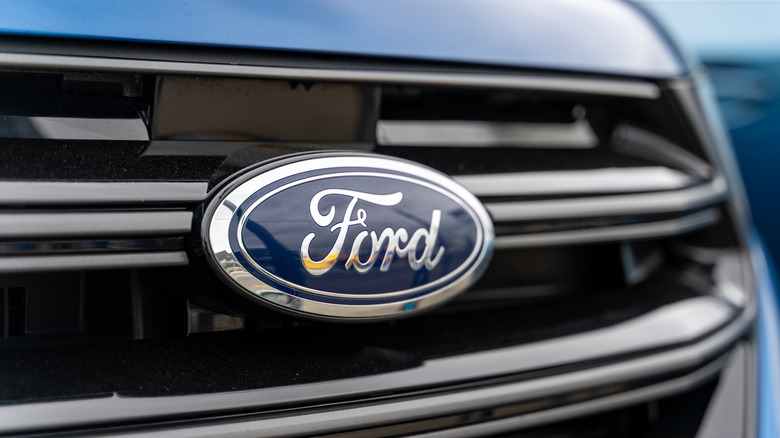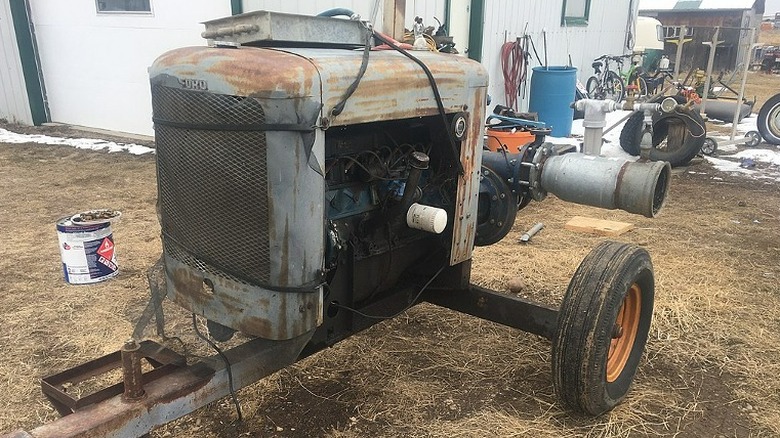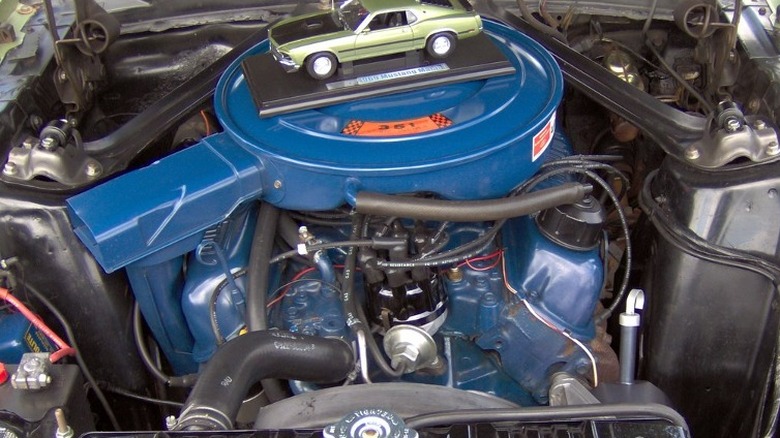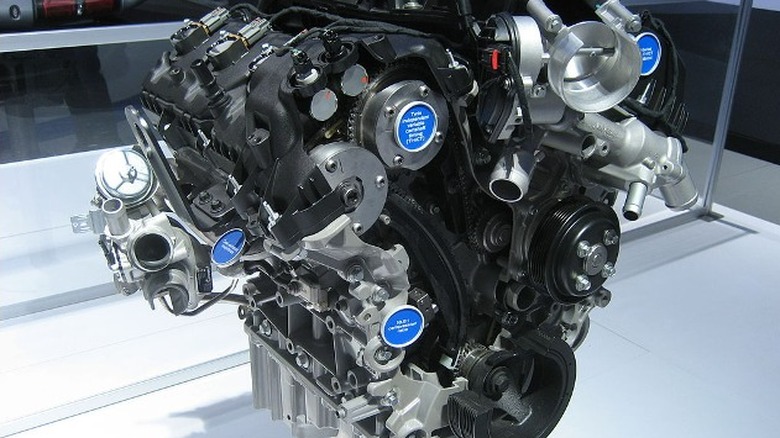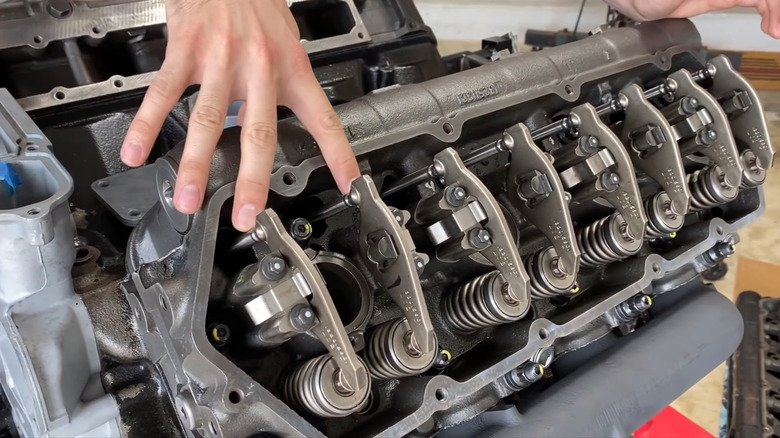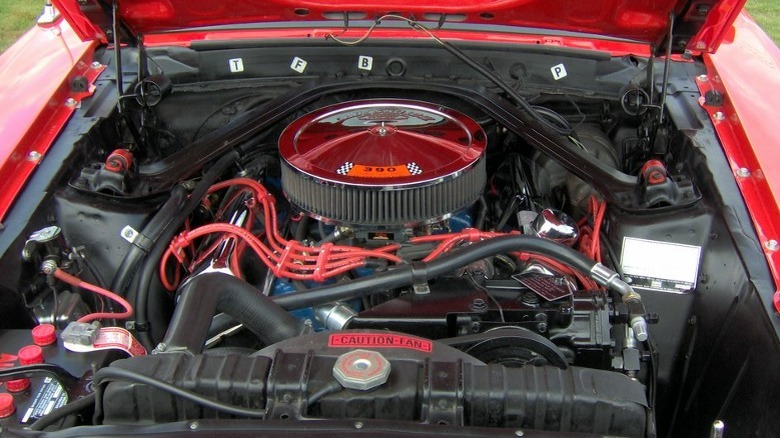5 Of The Best Engines Ever Put In A Ford Truck
Ford has long been an industry leader in developing consumer truck models. In 2022, Ford F-series trucks remained the best-selling truck in the United States. This was Ford's 46th consecutive year as the industry standard bearer. One primary reason for this consumer trust in the Ford name is the engines that have continued to underpin the vehicles' performance.
Across the spectrum of truck uses, Ford F-series trucks are a staple on job sites of all kinds, as well as consumer driveways and garages for use in hauling boats, home improvement gear, landscaping equipment, and even nothing at all. Drivers of all stripes love the Ford F-series truck platform, and the appeal has grown massively, even beyond the vessel's initial use case.
Driving a truck allows for serious haulage capability, ample bed storage, and a growling engine beneath the hood. These features merge to create the prototypical truck owner's experience. In a Ford, this has often meant using an industry-favorite powerplant and some of the most impressive propulsion technologies of the time. Over the years, many excellent Ford engines have stood out as some of the best in the business, not just among Ford engines. These are the five most impressive motors that have ever sat under the hood of the iconic Ford truck badge.
300 cubic inch Inline Six
The Ford 300 is an Inline Six engine that helped build the backbone of American infrastructure. It was developed in 1965 and quickly became one of the most iconic and trusted engines under any work truck hood. It was the primary workhorse in F-series trucks built by Ford across many decades until it was replaced in 1996.
The Ford 300 wasn't just a powerhouse in F-series vehicles, however. It's a staple in UPS trucks, generators, tractors, and many other worksite pieces of equipment that demand serious power (like a wood chipper or water pump). The '90s models produced 150 horsepower and 260 lb-ft of torque. These numbers may seem pedestrian on paper, but the engine remained a job site must for any serious work crew.
The key to this engine's success came in its low rpm torque. The Ford 300 was virtually impossible to break and would provide most of its power at an astonishingly low threshold of just 2,000 revolutions per minute. The engine also powered three Baja 1000 winning trucks over the years.
[Featured image by Redelback49 via Wikimedia Commons | Cropped and scaled | CC BY-SA 4.0]
5.8L 351 Windsor
The Windsor engine is one of Ford's most impressive feats of modern engineering. The massive "small block" engine takes its name from the Windsor Engine Plant that birthed it in Windsor, Ohio. It was first produced in 1962 and quickly made a name for itself among truck aficionados. The Windsor engine first made its way to the market in 1969 as the power production for a Mustang Mach 1. But in 1981 it had made its way into Ford's lineup of trucks and was the second most potent engine available to truck owners behind only the 460 model.
The engine remained an integral part of the F-150 infrastructure for many years, offering itself as an option for selective buyers until 1997. The engine has come back in the Ford Lightning models, however. The engine provides immense torque, with horsepower taking a backseat. This gives the Windsor small block incredible towing capacity at a low engine rev rate, with the Lightning version offering 340 lb-ft of torque at 3,200 rpm. This model produces 240 horsepower, though, still a notable power output to be sure.
[Featured image by sfoskett via Wikimedia Commons | Cropped and scaled | CC BY-SA 3.0]
3.5L EcoBoost V6
The EcoBoost V6 has been called the most reliable F-150 engine that's ever graced a Ford truck. It's a 3.5L example that may be slightly surprising on a list of enormous power and larger-than-life displacement figures. Yet, the EcoBoost engine is a shining example of engineering work.
The 3.5L EcoBoost was an optional powerplant in F-150 models starting in 2011. The first generation engine produced 365 horsepower and 420 lb-ft of torque. In 2017, the second generation EcoBoost V6 amped up this power production, registering an increase to 400 horsepower and 500 lb-ft of torque. This makes the engine a serious rival to the larger V8 varieties that have graced other Ford trucks and those from other brands. Yet, the V6 remains a smaller and more fuel-efficient option while offering the same essential power to a truck owner who may need to haul some serious weight or take on rough terrain at a moment's notice.
[Featured image by Dana60Cummins via Wikimedia Commons | Cropped and scaled | Public Domain]
7.3L Powerstroke V8 Diesel
The Powerstroke V8 was a revolution in engine technology. The 7.3L V8 is a monstrous addition to the Ford truck lineup, and drivers often point to the longevity of the powerplant's high torque output as its primary selling point. It's one of the most durable and reliable engines ever to hit the market, and vintage examples will fetch a significant resale price, even today. Diesel engines are well known for their improved performance in heavy workload-bearing vehicles, and the 7.3L Powerstroke was built with this exact purpose in mind. Produced by International Navistar, the engine went directly into Ford's Heavy Duty truck lineup.
The success of the enormous diesel engine can be seen in Ford's sales figures from the period. More than 2 million Super Duty trucks, reliant on a 7.3L Powerstroke V8, were sold until the engine was replaced in 2003.
The later model year varieties were gifted with the highest performance output of the bunch. 2000 to 2003 7.3L Powerstroke V8s produced 275 horsepower and 525 lb.-ft. of torque in Ford trucks that utilized the six-speed manual transmission pairing.
390 FE V8
The 390 FE V8 was a prominent feature in vintage Ford trucks. The FE engine was introduced to the F-series trucks in 1967 and remained a highly sought-after choice for around a decade. The FE engine initially found a home in Mustangs, Thunderbirds, and others (including Police Interceptors from Ford). It also played a role in powering Mercury sedans. The engine was developed in 1961 and was eventually phased out in 1976.
The 390 FE V8 is a 6.4L gasoline engine that produces 335 horsepower and 427 lb-ft of torque in the 1967 and '69 models. Even though it's been long relegated to the history books in new truck development, the high torque rating and durability of the engine make it a favorite among classic car collectors and those interested in refurbishing or driving vintage examples to this day. Modern uses of the engine run the gamut from racers that utilize battle-tested, vintage powerplants to work vehicles that demand reliability and consistent power production in all types of workplace conditions.
[Featured image by sfoskett via Wikimedia Commons | Cropped and scaled | CC BY-SA 3.0]
